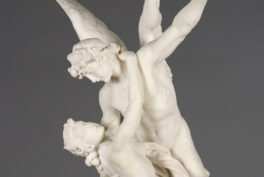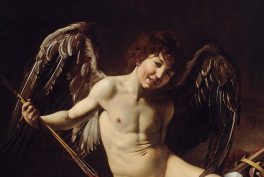1. Cupid’s Birth is Veiled in Mystery
Cupid (or Eros), the god of love and desire, first appears in ancient Greek and Roman myths and legends. Various versions of his origin story exist, but none mentions exactly how he was born or who his parents were.
According to one version, Cupid was the son of Venus, the goddess of love, and Mars, the god of war. This version also states that Deimos and Phobos, representing fear and panic, and Harmonia, representing harmony, were born from the same union. These figures symbolize the complex and often conflicting emotions that arise from love and war.
Another version suggests that Cupid was one of the primordial gods born from Chaos. He existed before the creation of the world alongside Gaia and Tartarus. This version establishes the significance of love and desire as fundamental forces in the universe.
In visual art, Cupid is often depicted alongside Venus, as he is not only her son but also her companion.
Lorenzo Lotto’s 16th-century painting Venus and Cupid features an unusually comical scene. Venus is lying on a luxurious cloth and crowned with a headband, with her son Cupid urinating through a laurel wreath onto her.
What is going on? While it entertains the viewers, this painting is rich in symbolism. Cupid’s actions stands for fertility and desire, while Venus embodies beauty and love. The painting might have been a wedding gift, as giving meaningful and playful art to newlyweds is an Italian custom.
In paintings featuring Cupid and Venus, Cupid is often portrayed as a young, chubby boy prone to mischief. For instance, in a painting by Paolo Veronese, we see the mother Venus tenderly taking the bow away from her disobedient son Cupid. Like any ordinary boy, he reaches out to retrieve his dangerous toy.
2. He Has a Brother
According to one version of Greek mythology, Eros, the god of love, had a brother named Anteros. While Eros embodied passionate and often blind love, Anteros was responsible for mutual affection and punished those who mocked love.
Cupid, or Eros, was depicted as fair-haired, while Anteros had dark hair. Due to the scarcity of information about Anteros, it is believed that his image eventually merged with that of Cupid. However, images of Anteros can still be found in ancient art.
3. His Arrows Can Be Punishment
Cupid is a boy with wings who shoots arrows from a bow kept in his quiver. There are two types of arrows that the Roman god of love uses: gold-tipped arrows, which awaken love and desire, and lead-tipped arrows, which cause disgust and hatred.
Apollo, the god of light, was once hit by one of those arrows as he was mocking Eros and looking down upon the winged boy’s prowess as an archer. This infuriated Eros. So he shot a golden arrow at Apollo and a lead arrow at a nymph named Daphne. As a result, Apollo fell in love with Daphne and pursued her, but she, not wanting to be with him, asked her father (Peneus, the river god) for help. Her father, hearing her plea, granted her wish and transformed her into a beautiful laurel tree.
This Rubens painting captures the moment when Cupid aims his arrow at Apollo, who has just defeated the serpent, Python, with his bow. The hero and monster slayer was instantly rendered powerless.
The tale of Apollo and Daphne illustrates how Cupid (or Eros) must not be taken lightly.
4. He Fell in Love
Being the god of love, Cupid was also not immune to strong feelings himself. Assigned by Venus to make Psyche, a beautiful mortal girl, fall in love with a terrible man, he found himself captivated by Psyche’s beauty and instead fell for her. Their love story unfolds with intriguing twists, which you can explore in this article.
Rest assured, the tale concludes happily, with Cupid and Psyche marrying and residing together on Olympus. From their union, Voluptas, the goddess of pleasure, was born.
Cupid plays a significant role in this story. Him and his beloved are frequent motifs in paintings and sculptures across different periods, from the Classical era to Baroque art.


















